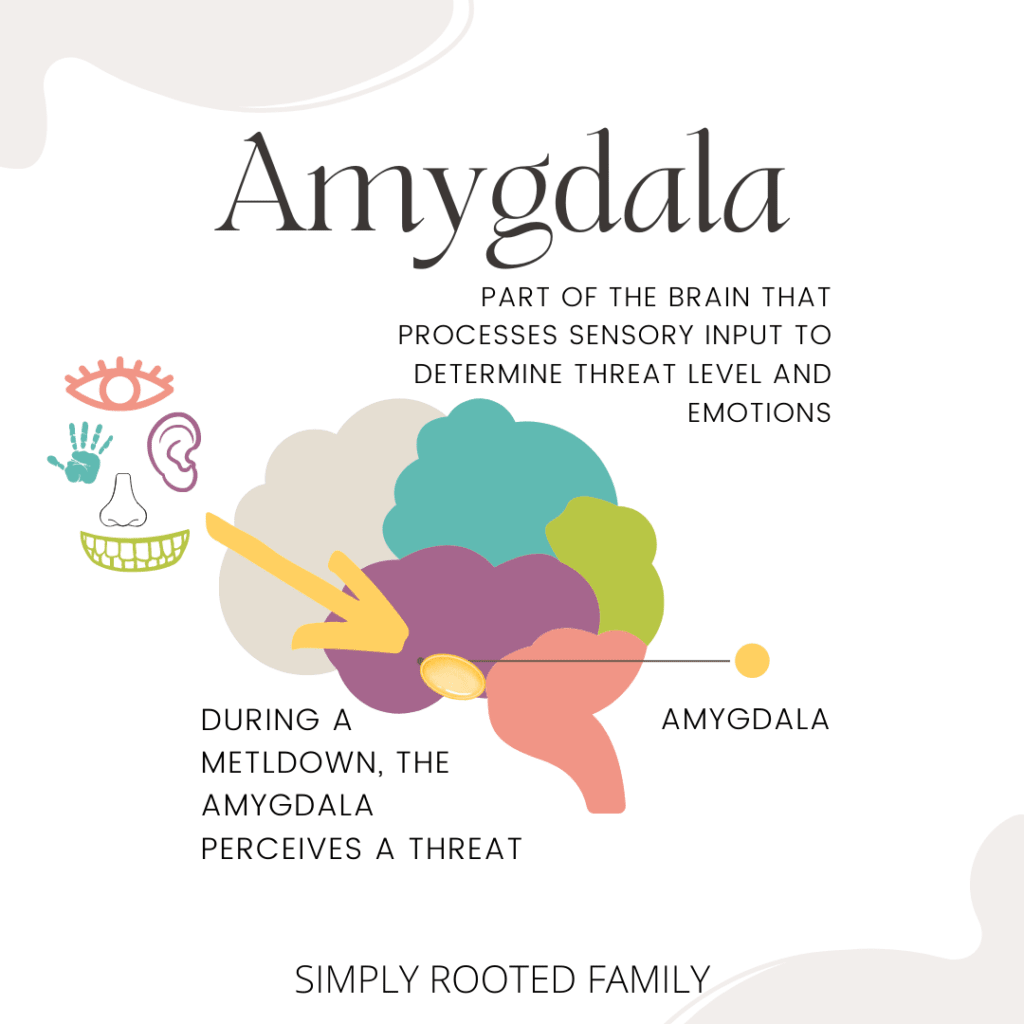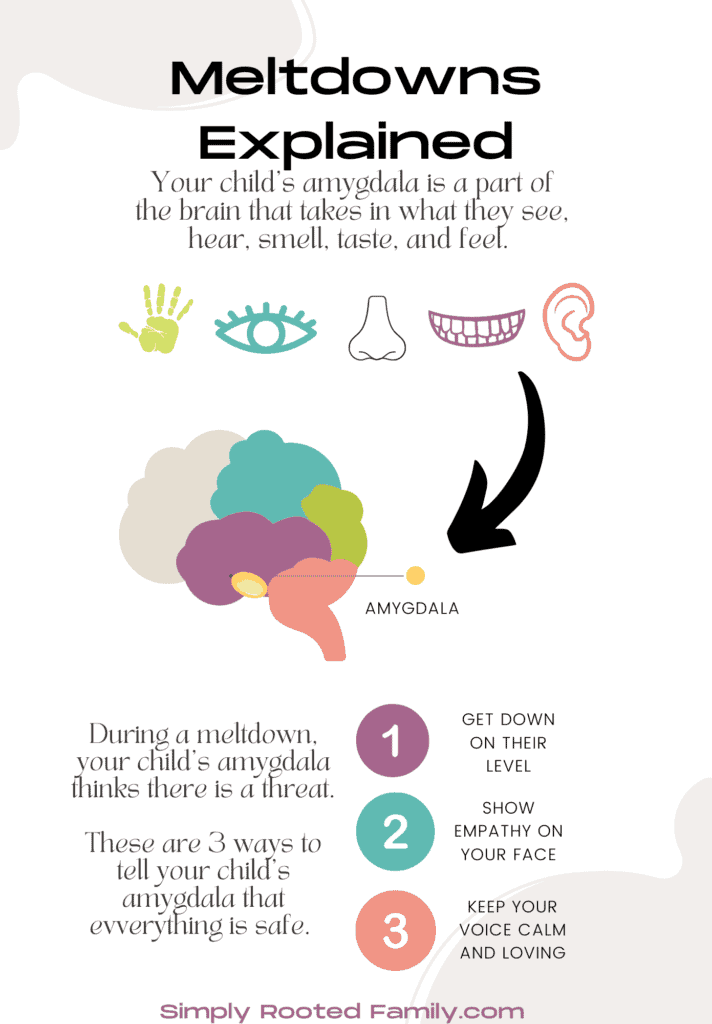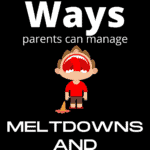Meltdown and Tantrum Tips for Overwhelmed Parents: Meltdowns and tantrums are a natural response to big emotions in young kids. Help your child have fewer tantrums and shorter meltdowns with these new skills.
So many parents have experienced this exact scenario that it has become a cliché.
We are at the grocery store. Yeah, you know where I am going with this.
I give my children the we-are-just-here-for-milk talk, and remind them that they are not going to get candy.
When the shopping cart approaches the snacky-snack isle, we instantly see a loss of control and signs of distress.
Child sees candy. Child demands candy. I refuse, and they have a full-blown emotional meltdown.
If you decide to stand by your original ‘no candy’ rule, you are left marching through the store dragging your breath holding child – looking like a bad parent.
It feels like a lose-lose situation.
The reason you may be unknowingly nodding your head in familiar agreeance is that this kind of response at home or in public places is totally natural.
The good news is, although parents can’t abolish these classic temper tantrums, they can educate themselves on why these occur and do these 3 different things to create an emotionally safe place for our kids to work through an emotional explosion.
You may also like: How to Wire Your Kid for Happiness Later in Life
The Difference Between Meltdowns and Tantrums
At first glance, meltdowns and tantrums may look very similar.
In fact, we often use the words interchangeably.
These words actually describe two very different childhood experiences and understanding the difference is the first step in managing negative behavior.

Taming Tantrums
Typical tantrums occur when your child is in control of their own emotions. There is a goal and a purpose behind their fireworks of anger.
Commonly, these emotional outbursts are the result of immediate power struggles (such as wanting candy at the store).
They want something, and they are reacting to get your response.
These are a normal part of child development, as your child is still trying to develop emotional regulation and expand language skills.
Try these calming activities for kids or teach your kids how to manage anger here.

Tantrums of young children are often short-lived. The child’s tantrum typically ends with normal measures, such as when get what they want or they get tired and eventually move on.
Children and older kids prone to tantrums often respond well to rewards system and natural consequences.
Related: How to Get Kids to Listen the First Time
Managing Meltdowns
On the other hand, a meltdown is the result of a child who feels out of control.
Meltdowns occur during an overwhelming situation, when the child is not emotionally in control and does not have an end goal.
Some common triggers of meltdown behavior include exhaustion, sensory overload, or unexpected changes.
While meltdown behavior is common in younger children, frequent meltdowns can be the sign of a information overload or sensory processing disorder.
High sensitivity (also called sensory processing disorder) is a temperament type – one that’s shared by 20% of the population.
This occurs when the sensory input or sensory stimuli (what a person is experiencing from their 5 senses) becomes overwhelming.
In the book The Highly Sensitive Child, Clinical Psychologist Dr. Elaine Aron explains common traits that are shared by highly sensitive kids. These traits include:
- Intense sensory meltdown– ex: cries easily and is prone to social anxiety
- Deeply processes experiences– thinks about things that happened for a long time aka deep thinkers
- Easily overstimulated by sensory input– needs down-time in a quiet place
- Sensitive to subtle changes or sensory stimulation – loud music, bright lights or new foods
Children who experience meltdowns benefit from learning emotional techniques (such as deep breathing).
Use these tools to coach your kid through feelings and emotions.
What Causes a Meltdown or Tantrum?
To understand WHY kids freak out from time to time and how to fix it, it is helpful to have a quick biology lesson.
Let’s start with the part of the brain associated with emotional processes: the amygdala.
Although the amygdala is smaller than an almond, it is responsible for the perception of emotions such as anger, fear, and sadness.

When a child is having a meltdown, they are experiencing an “amygdala hijack.” The emotional part of their brain takes over and reacts as if it were being attacked by a predator, and this triggers a “fight, flight or freeze” reaction.
This happens in parents, too. Learn about how to be a calm parent here.
Of course you cannot reason with them, bribe them, or discipline them OUT of a meltdown! Their amygdala is in control of their actions.
However, there is an effective way to help manage your child’s behavior while supporting them (and their amygdala).
You may also like: How to Help a Kid Who Cries all the Time
3 Ways Parents Can Help with a Meltdown or Tantrum
Whether your child is lost in a meltdown or tantrum, there are three simple ways parents can signal signs of safety to their child.
These little things should be done at first sighting of symptoms of escalation to provide an emotionally safe place for your child and encourage good behavior.
1) Step One: Get on Their Level
When a parent crouches down to eye-level, they are signaling to their child’s amygdala that there is no threat.
It tells your kid’s brain that you are not a big threat, you are on the same team at them.
Also read: How to manage a 7 year-old throwing tantrums

2) Step Two: Show Empathy on Your Face
Showing empathy to your child during a meltdown is one of the easiest ways to help them (and their amygdala) feel safe.
What is the best way to show a child empathy? With your facial expressions. An angry or blank expression signals a threat to a child.
Puff out that bottom lip and open your eyes wide and approach with love.
Related: Disciplining a Defiant Child
3) Step Three: Focus on Your Tone of Voice
A shrill or cold tone of voice will only confirm your kid’s fearful emotions.
Tell your child, in a calm voice, you hear what they are saying. You are there for them and you are listening.
Don’t worry about discipline or responding to current situation. Your job is to first help them feel calm and safe.
You can also help by teaching your kids these calming mindfulness techniques.

Now, read 3 ways to transform your body language when speaking to your child.
Final Thoughts on Meltdown and Tantrum Support
Next time your child is showing signs of an oncoming or current emotional breakdown, talk to your kid’s amygdala before taking to them about the situation.
Use these three simple tips to show them that YOU are their safe place.
If you found this helpful, follow us on Facebook for more ways to raise kids who are healthy at home and strong in the world.
If you feel your child seems to be experiencing very frequent or severe meltdowns (such as autistic meltdowns or signs of autism spectrum disorder) reach out to your health care provider immediately.


The Difference Between Calm Parenting and Explosive Parenting - Simply Rooted Family
Monday 25th of April 2022
[…] Related: How to Handle Meltdowns by Providing a Safe Space for Your Kid […]
Anger Management Activities that Teach Coping Skills to Easily Angered Kids - Simply Rooted Family
Monday 25th of April 2022
[…] EXACTLY what is going on in the brain during a meltdown […]
Be Your Kid's Emotions Coach with These 5 Simple Activities - Simply Rooted Family
Friday 1st of April 2022
[…] is to mirror our kids frustration, This is, of course, understandable. When a child is having a meltdown, we often get equally irritable – whether at them or for […]
W. Santiago | Literal Med
Monday 14th of March 2022
This is very good. I liked that you differentiated between tantrums and meltdowns. Thanks!
aisasami
Friday 11th of March 2022
Great tips on how to identify and resolve such behaviors. I use the same methods in the class as 3 years old always have a tantrum.